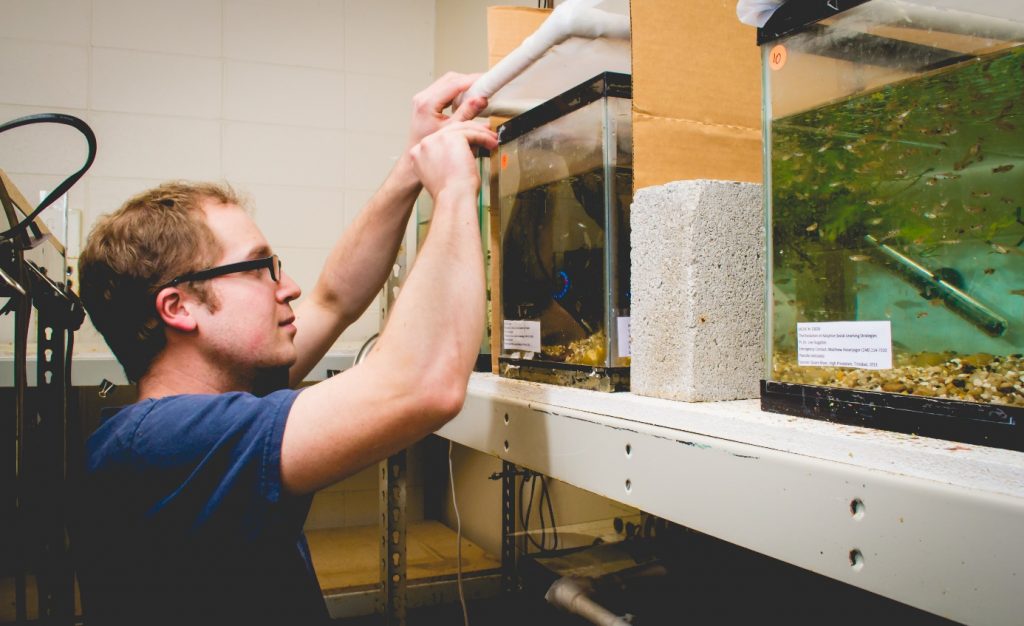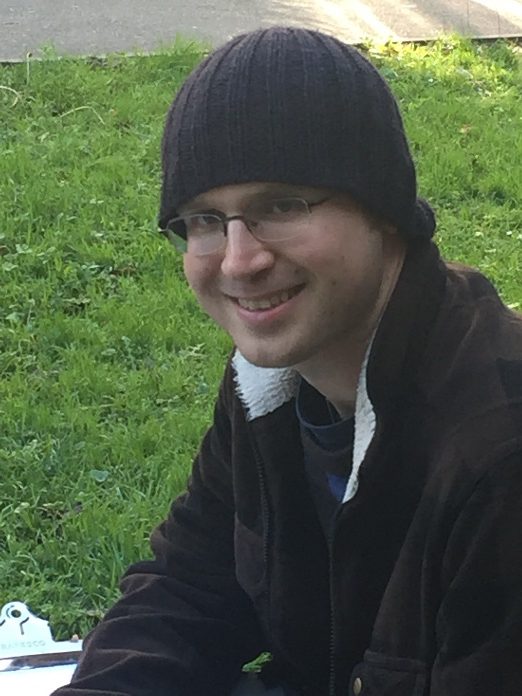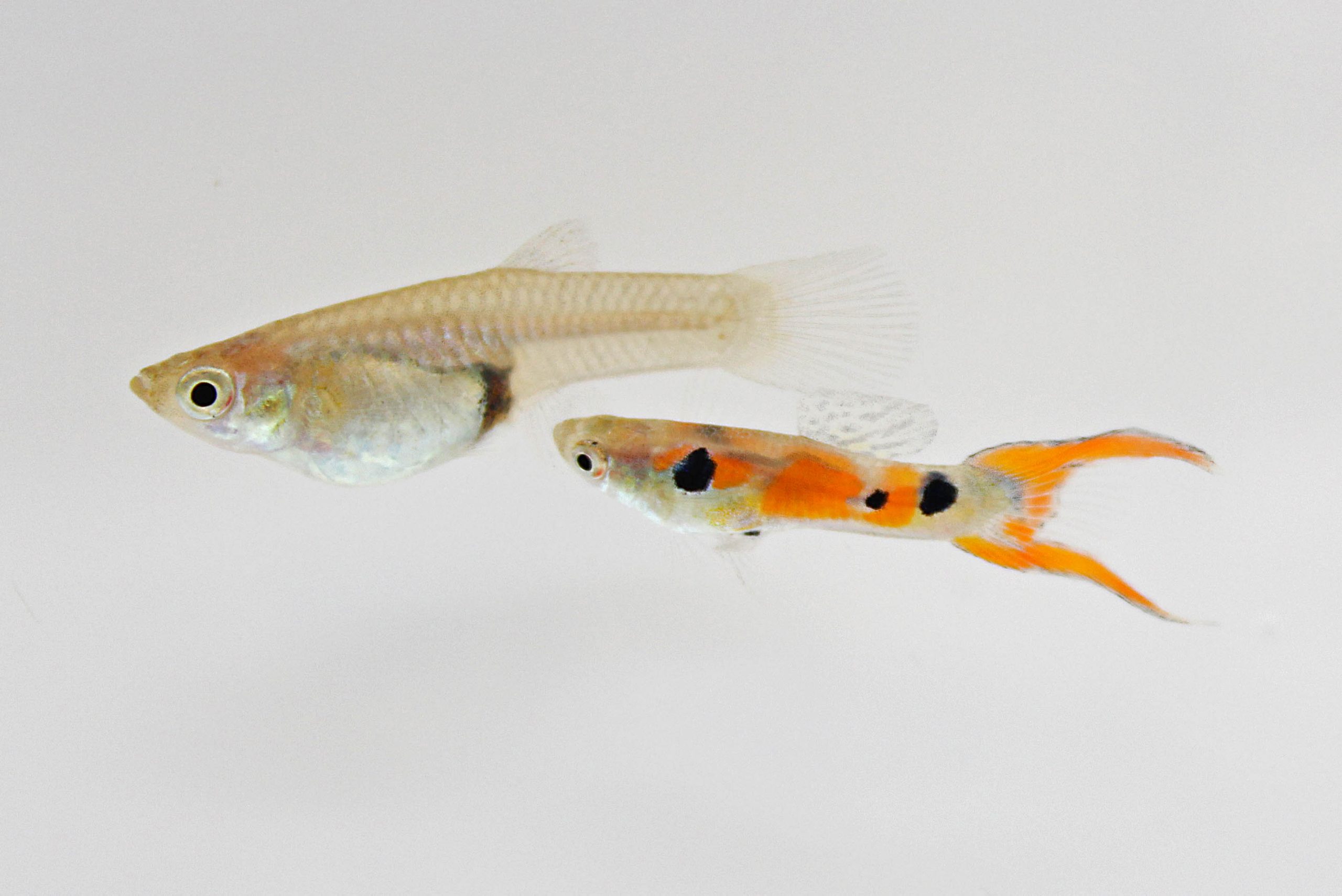Personality composition may determine the spread of social information in shoaling fish
Matthew Hasenjager talked to Cultured Scene about his recent findings that how individuals learn is conditional on group personality composition in guppies. The whole study by Matthew and colleagues has been published in Proceedings of the Royal Society B.
The paper
Cultured Scene (CS): What is the key finding of your study?
Matthew Hasenjager (MH): We found that whether Trinidadian guppies learned to exploit a novel foraging opportunity depended more on the behavioural composition of their group than on their own personality. The task required that individuals enter an opaque cylinder through a small hole in its base in order to discover and consume the food located within. Guppies were more likely to solve this task in groups composed primarily of shy fish than in bold-dominated ones, where boldness was measured as how rapidly an individual recovered following a simulated predator attack.
What’s more, not only did group personality composition determine the likelihood of solving the task, but it also directed how the solution spread within groups. Within groups composed primarily of bolder individuals, bold fish learned the solution from knowledgeable associates more rapidly than their shy counterparts. Yet as groups became increasingly composed of shy individuals, bold guppies no longer learned more rapidly, but instead were more effective in promoting learning in others. Contrary to our expectations, however, bolder individuals were no quicker to solve the task on their own.
By directing the flow of information, group personality composition may alter the costs of learning, dependent on an individual’s personality. Individuals may therefore benefit by selecting social environments that complement their own personality.
CS: Can you briefly summarize how “animal personality” is defined and what types of personalities are typically assessed for experimental studies?
MH: Animal personality refers to individual differences in behaviour that are repeatable over time and consistent across contexts. For example, a bolder guppy might consistently forage further from cover than its associates, potentially putting itself at greater risk of predation in return for better foraging opportunities. These risk-taking tendencies could also extend across contexts, such that this individual also recovers more rapidly after predator encounters and tends to occupy peripheral positions when shoaling.
Animal personality studies classically measure traits such as exploration (response to novelty), activity level, aggressiveness, sociability, and boldness (response to risk). Increasingly, studies have also considered consistent individual differences in other traits, including cognitive traits, social roles, and social network position.
CS: Why is this topic important and what implications for the importance of accounting for animal personality in studies on social learning can be drawn from your study?
MH: Personality traits are relevant to social learning in that they capture differences in how individuals tend to explore and interact with their environment, including their social environment. This link between personality and learning was recognised early on, but we also know that how personality is expressed can strongly depend on social context. Our study illustrates that the relationship between personality and social learning is not static, but can vary according to the mix of personalities within a group. For example, whereas bold individuals were faster to learn socially than shy individuals in bold-dominated groups, this difference was not present in shy-dominated groups. More generally, our results highlight that when studying social learning, it is important to consider how the social environment can modulate the relationship between individual phenotype and social learning processes.
The process
CS: How did you arrive at the idea for the study and was there a specific reason for using guppies as your study organism?
MH: Back when this study was first conceived circa 2014, there had been a recent string of studies linking personality to social learning propensities, usually (though not always) finding that more risk-averse individuals were more likely to use social information. However, as I alluded to earlier, previous work had also shown that the expression of personality often depended on the social environment. Network-based diffusion analysis had recently been developed as an approach for studying social learning within freely interacting groups. To me, this seemed a great opportunity to investigate the relationship between personality and social learning and to determine whether this relationship was modulated by the personality composition of a group.
Guppies were an excellent system to use for this study for several reasons. As a classic model system in evolution and behavioural ecology, guppies had previously been shown to use social learning in diverse contexts and to exhibit consistent individual differences in personality along a number of behavioural dimensions. Guppies were also an attractive system for logistical reasons. They are easily kept in captivity and are prolific breeders, which allowed me to obtain a large number of replicate groups with the desired behavioural compositions. In total, I ended up measuring the boldness of 853 individuals across 9 months to create our 36 experimental groups.
CS: How did you decide on which personality type is important for your study question and how did you assess your guppy’s personality experimentally?
MH: Initially, I thought to measure three traits—activity, exploration, and boldness—and combine these measurements into a composite trait. However, this was challenging in practice. The relationship between these traits was not always consistent, which made it difficult to form groups with specific behavioural compositions. In the end, I decided to focus on boldness for two reasons. First, interacting with the foraging task likely involved an element of risk, given that it was a novel object and entering it obscured an individual’s line-of-sight to any shoal mates outside. I therefore expected that boldness would influence an individual’s likelihood of solving the task, at least through individual learning. Second, as boldness is responsive to the social environment (individuals in groups often behave more boldly than when they are alone), I thought that social context might modulate the relationship between boldness and learning.
To measure boldness, I simulated an aerial predator attack in which a shadow swept rapidly over a tank, causing the guppy below to freeze. I then recorded how long it took an individual to resume moving after the “attack”. Each guppy experienced this process twice over consecutive days, though I had previously established that boldness measured in this manner was consistent over at least 5 days.
CS: What was the most challenging aspect of conducting the study?
MH: The sheer number of individuals that I needed to assay to form the experimental groups. I established cut-offs to ensure good differentiation between the bold and shy fish, but I was limited in the number of fish whose boldness I could measure at a time. There were several times that there were not a sufficient number of individuals within a cohort that met the criteria to allow me to establish an experimental group. As a result, it took the better part of a year in the lab to obtain the desired sample size of groups.
CS: What were the best and worst aspects of data collection – any funny stories? Any specifics about working with guppies?
MH: It’s technically post-data collection, but I always enjoyed getting to finally build and visualize the social network for each group—to see in such a compact way all the individual and group-level variation in social behaviour laid out before you. The worst aspect was individually marking the fish. It was necessary for the experiment and I took every precaution to minimise potential suffering, but sticking needles into fish is not my favourite thing to do.

Publishing
CS: How did you manage the writing process? Was it straight forward, or were there challenges?
MH: The most challenging aspect of the writing was clearly communicating how we performed the network-based diffusion analysis (NBDA). Even the basic NBDA model can be quite a complex approach to describe and here we extended it in several ways (e.g. different types of networks, different ways of partitioning those networks). However, the approach is central to the paper, so it was important that we present it in such a way that even someone without any previous experience with NBDA could follow our approach and understand what the model parameters tell us.
CS: How was the peer review process?
MH: It was very positive. The reviewers had a number of helpful suggestions that I believe greatly improved the paper. For example, we added more descriptive statistics to provide better context for the NBDA and we were able to address a potential alternative explanation for our findings that we had not considered.
What’s next?
CS: Will you be following up on this research? What questions interest you next, based on your findings?
MH: I’ve no immediate plans to follow up on this project, as my postdoctoral research took a slightly different direction from my PhD. As a postdoc, I have been using NBDA and other social network approaches to investigate how honeybees combine different sources of social information when searching for food. However, I remain interested in how individual variation—whether in terms of personality or other phenotypic traits—scales up to shape collective dynamics, including the spread of information within groups.
If I have the opportunity to more directly follow up on my PhD research in the future, I believe it would be fascinating to focus more on how different group compositions come about. We’ve shown that how individuals learn about their environment can depend not only on their own personality, but on that of their group mates. As a result, the costs of learning for different personality types may vary depending on group composition. Can individuals distinguish between groups based on personality composition and if so, do individuals actively prefer certain compositions? How stable is group personality composition within guppies’ fission-fusion system? Are certain group compositions more common than others?
CS: As early career researchers, we’re always learning. Is there anything you’d do differently in future, based on your experiences conducting this study?
MH: As I mentioned earlier, I had initially wanted to account for multiple forms of personality variation when constructing my groups, but settled on boldness for methodological and conceptual reasons. However, in hindsight, I wish that I had still gathered data on other traits, such as exploration and sociability, even if groups were still constructed based on boldness. Having that information available would have been useful when analysing and interpreting the data. For example, while we found no evidence to suggest that bolder individuals were faster to solve the task on their own, it may be that such effects would only have been apparent after also accounting for variation in exploration tendencies (i.e. responsiveness to novel stimuli).
CS: Finally – what do you think are some of the big questions / challenges facing the field of social learning?
MH: I believe there remains much to learn about the ontogeny of social learning. For example, how do individuals learn the value of social information and can different learning experiences explain individual variation in social learning strategies? In the past, such questions were often inaccessible due to the constraints in continuously following individuals across their development while controlling their access to different information sources. With advances in automated tracking, however, I believe there is great potential for investigating how responses to social information develop and change over time, at least in some systems.
CS: Thank you, Matthew, for giving us some insight into your fascinating work in the fiel of social learning in guppies!
The publication

Dr. Matthew Hasenjager is a postdoctoral researcher at Royal Holloway, University of London. He is interested in the mechanisms that drive variation in animal social networks and the consequences of this variation for eco-evolutionary processes. For his PhD research, he used social network analysis to study how factors such as group composition and predation risk influenced the spread of social information within shoals of Trinidadian guppies. As a postdoctoral researcher, he has been investigating how honeybees integrate different sources of social information when searching for food in order to better understand the selective pressures that have shaped the evolution of honeybee dance communication.
Twitter handle:
@matthasenjager
Personal website: https://matthewhasenjager.weebly.com/
About the author
Stefanie is a committee member of ESLR and Editor in Chief for Cultured Scene. She is currently a doctoral student at University of Siegen (Germany), studying social learning and mate choice in fish.
If you are interested in contributing to Cultured Scene, you can contact her at mail@stefaniegierszewski.de or via Twitter (@Steffi_Giersz).
